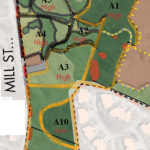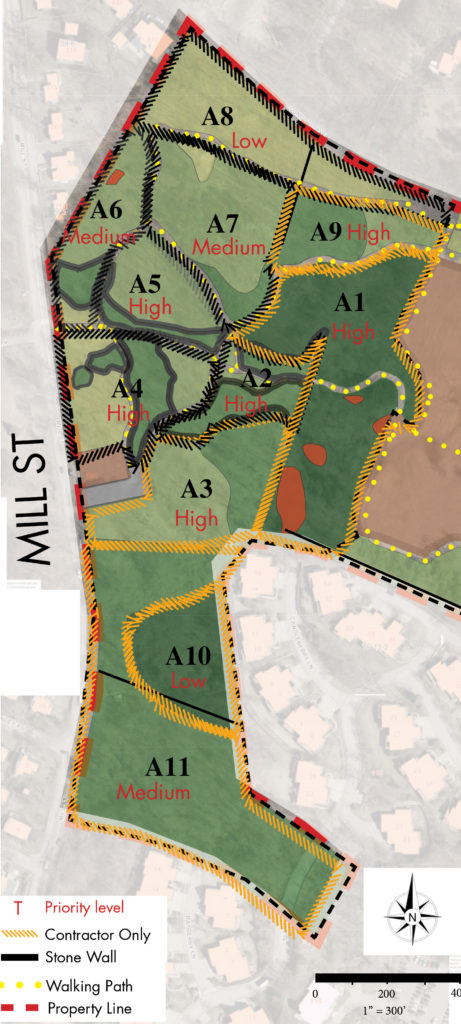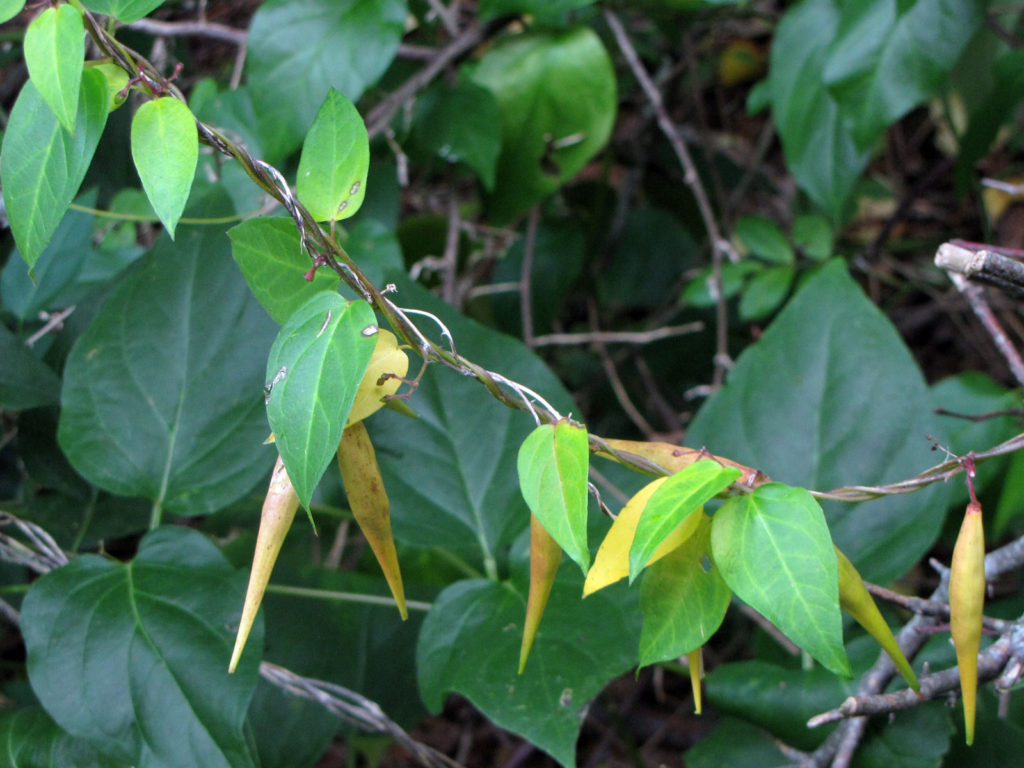
By Jeffrey North
Late last year, field technicians engaged by the Land Management Committee for Lone Tree Hill (LMC) and the Judy Record Conservation Fund began a multiyear campaign to restore select parcels of the Lone Tree Hill conservation land. These stewardship projects focused first on invasive plant removal at Area A1. Restoration specialists from Parterre Ecological Services hand-cut the bittersweet vines that were smothering the trees there and deployed a forestry mower to obliterate (if only temporarily) the buckthorn and multiflora rose.
The forestry mowing radically altered the appearance of that portion of the property, prompting the few visitors to ask if perhaps the area was being prepared for the construction of condominiums or other commercial undertakings. No, the property is protected by a conservation restriction, but it is not protected from invading, damaging plant species.
The restoration plan for Lone Tree Hill (LTH) has been documented in the Invasive Plant Management and Native Plant Restoration Plan by Parterre and presented to the LMC in May 2020. The LMC approved plans and funding for forest and meadow restoration work on this conservation area, as previously reported in this newsletter (see “Committee Battles Invasives at Lone Tree Hill,” Belmont Citizens Forum Newsletter, January 2021, and “Committee Plans Lone Tree Hill Restoration,” Belmont Citizens Forum Newsletter, July/August 2020). The Judy Record Conservation Fund is providing matching funds for these initiatives.
After the initial preparation of the restoration area, the spring of 2021 saw the launch of this multiyear effort to restore native plant communities and enhance biodiversity in the most visited section of the conservation property.

A partial map of Lone Tree Hill showing mapped areas and their rating for density of invasive species. Area A1 is in the upper right. Source: Parterre Ecological Services
Restoration plan year 1
Starting in early May, trained horticulturalists from Parterre Ecological Services began removing invasive plants. They treated flowering garlic mustard throughout the area and spot-treated poison ivy vines near pathways, honeysuckle, lily of the valley, Morrow’s honeysuckle, and black swallow-wort. The acre immediately northwest of the parking lot was prepared for seeding and meadow enhancement by applying spot herbicide and hand-weeding aggressive non-native plants.
As invasive plants are cleared, space is made for emergent plants—surprises from the seed bank. Canada mayflower, silky dogwood, carex sedge, and false Solomon seal have filled some of the gaps. A few areas have Jack-in-the-pulpit coming up. While we see some resprouts of the buckthorn that was cut last year, we also see progress and improved competitive positions for the native plants. But the invasive plants are pernicious, often resprouting weeks after treatment. “It’s an uphill battle,” noted Parterre project manager Gabe Siegel. “This year the area looks like a bad haircut.”
In early June, the field technicians returned to apply herbicide to the black swallow-wort in the main meadow and edge areas and to mow Japanese knotweed. Later in June, the restoration crew sowed a cover crop of Canadian wild rye over sunny areas of the northern portion of our restoration area. This area gets the most sun and has some of the most disturbed soil, so the ryegrass is intended to defend the area against resprouting invasives until the natives re-emerge or are reintroduced and replanted. Other native plants present include several species of goldenrod, Virginia creeper, bluestem grasses, and sumac.
In early July, volunteer Joe Hibbard, a landscape architect and nearby resident, worked with Parterre to begin removing buckthorn in an area adjacent to the main restoration area. Hibbard could be found most Mondays near the path closest to Concord Avenue, making progress against the buckthorn and reclaiming the meadow and oak-pine forest. Following in his tracks, Parterre will cut the buckthorn again and carefully dab the stalks with herbicide so that only the target plant is treated.
In July, more black swallow-wort was treated in the meadow and open spaces. This plant is often mixed in with common milkweed (which is prime monarch butterfly habitat) and so requires careful, selective treatment to preserve the milkweed and other surrounding species.
In August, the horticulture technicians treated more black swallow-wort, bittersweet, grape, porcelain berry, buckthorn, tree of heaven, and multiflora rose. In early September, during the most effective time of year for treatment, the technicians focused on treating Japanese knotweed with herbicide in the wooded side of section A1 and several other patches near the residences and around the cell tower. Knotweed either received a foliar spray application or cut stems were treated with herbicide.
New pollinator meadow at Mill Street
A new pollinator meadow will be cultivated near the parking lot on Mill Street. Currently, the site is a meadow full of weeds including yellow foxtail, mugwort, ragweed, swallow-wort, lambs quarters, three-seed mercury, and nutsedge. The 6,400-square- foot area near the bicycle rack just north of the parking lot will become especially attractive to the birds and the bees.
After careful mowing in mid-summer, invasive plant species near the bicycle rack were removed via hand-pulling and applying a foliar herbicide. Over several visits the thick patches of yellow foxtail grass by the parking lot were mowed and carefully sprayed, taking care to avoid the mature clusters of common milkweed. Several monarch butterflies have been seen laying eggs on the milkweed.
In early November, the area was seeded with a mix of pollinator-supporting native wildflower seeds, including anise hyssop, purple coneflower, blazing star, foxglove beardtongue, black-eyed Susan, smooth aster, and others.
Future Steps
This year, many invasive plant populations were managed aggressively, but they will still need additional treatment to make sure these persistent plants do not reestablish themselves. This persistence is part of what makes them invasive in the first place.
Some populations of invasive plants such as porcelain berry were knocked back and treated with herbicide, but since they were not the primary focus this year, they will certainly need additional attention.
In the first few years of management of established invasive populations, surprises will emerge from the seed bank. These plants have been dropping seed for several years and disturbing the area has created ideal conditions for germination. As time goes by, we will transition from treating established plants, to treating resprouting stems, to treating and preventing new emerging seedlings from reestablishing.
The Land Management Committee for Lone Tree Hill will meet with the Parterre Ecological Service team in early 2022 to review the progress made in 2021 and to plan the initiatives for the next season.
Thank You
The Land Management Committee for Lone Tree Hill and visitors to the conservation land are once again grateful for the continued financial support and sage guidance from the board members of the Judy Record Conservation Fund: Roger Wrubel, executive director; Eugene Record, treasurer; and Andrea Luckens, Mass Audubon.
Jeffrey North is managing editor of the Belmont Citizens Forum Newsletter and the ex officio Belmont Conservation Commission representative on the Land Management Committee for Lone Tree Hill.



Sorry, the comment form is closed at this time.